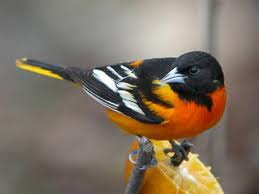Birds evolved from reptilian ancestors about 140 to 150 million years ago. The earliest known bird is the Archaeopteryx, several fossils of which have been found in Germany; about the size of a pigeons. Archaeopteryx had many reptilian features, including toothed jaws and lizard like tails, but it also had feathers and was undoubtedly a bird. Birds are the only animals with feathers, which clearly evolved from reptilian scales. As well as aiding birds in flight, feathers help them to maintain their bodies at a constant high temperature. Each feather has a horny shaft, a rachis and numerous branches, barbs. The barbs of the outer feathers are linked together by hooked branches, barbules. The wingtip feathers are primary or flight feathers; those nearer the body are secondary feathers.
Modern birds have no teeth and with their front legs turned into wings, their bills or beaks have to collect and process their food. The bill of each species is admirably suited to its diet. Many birds have lost the power of flight during their evolution. The ostrich the world’s largest living bird- grew too big to fly. However, its size and fast running in short burst give it plenty of protection. Rheas in South America, emus in Australia and cassowaries in New Guinea have evolved in similar ways and have all come to look alike, although they are not closely related. Birds living on islands with no mammalian predators often became flightless. The kiwi of New Zealand is a familiar example. Some of these birds died out when man introduced cats and other mammals, and many more are now in danger of extinction. Penguins cannot fly in the air, but they use their powerful wings as flippers to fly underwater.

0 comments:
Post a Comment
Note: Only a member of this blog may post a comment.